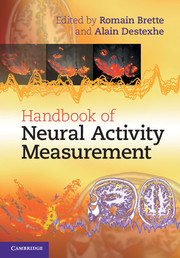Book contents
- Frontmatter
- Contents
- List of contributors
- 1 Introduction
- 2 Electrodes
- 3 Intracellular recording
- 4 Extracellular spikes and CSD
- 5 Local field potentials
- 6 EEG and MEG: forward modeling
- 7 MEG and EEG: source estimation
- 8 Intrinsic signal optical imaging
- 9 Voltage-sensitive dye imaging
- 10 Calcium imaging
- 11 Functional magnetic resonance imaging
- 12 Perspectives
- Plate section
- References
4 - Extracellular spikes and CSD
Published online by Cambridge University Press: 05 October 2012
- Frontmatter
- Contents
- List of contributors
- 1 Introduction
- 2 Electrodes
- 3 Intracellular recording
- 4 Extracellular spikes and CSD
- 5 Local field potentials
- 6 EEG and MEG: forward modeling
- 7 MEG and EEG: source estimation
- 8 Intrinsic signal optical imaging
- 9 Voltage-sensitive dye imaging
- 10 Calcium imaging
- 11 Functional magnetic resonance imaging
- 12 Perspectives
- Plate section
- References
Summary
Introduction
Extracellular recordings have been, and still are, the main workhorse when measuring neural activity in vivo. In single-unit recordings sharp electrodes are positioned close to a neuronal soma, and the firing rate of this particular neuron is measured by counting spikes, that is, the standardized extracellular signatures of action potentials (Gold et al., 2006). For such recordings the interpretation of the measurements is straightforward, but complications arise when more than one neuron contributes to the recorded extracellular potential. For example, if two firing neurons of the same type are at about the same distance from their somas to the tip of the recording electrode, it may be very difficult to sort the spikes according to from which neuron they originate.
The use of two (stereotrode (McNaughton et al., 1983)), four (tetrode (Recce and O'Keefe, 1989;Wilson andMcNaughton, 1993; Gray et al., 1995; Jog et al., 2002)) or more (Buzsáki, 2004) close-neighbored recording sites allows for improved spike sorting, since the different distances from the electrode tips or contacts allow for triangulation. With present recording techniques and clustering methods one can sort out spike trains from tens of neurons from single tetrodes and from hundreds of neurons with multi-shank electrodes (Buzsáki, 2004).
Information about spiking is typically extracted from the high-frequency band (≳500 Hz) of extracellular potentials. Since these high-frequency signals generally stem from an unknown number of spiking neurons in the immediate vicinity of the electrode contact, this is called multi-unit activity (MUA).
- Type
- Chapter
- Information
- Handbook of Neural Activity Measurement , pp. 92 - 135Publisher: Cambridge University PressPrint publication year: 2012
References
- 44
- Cited by



